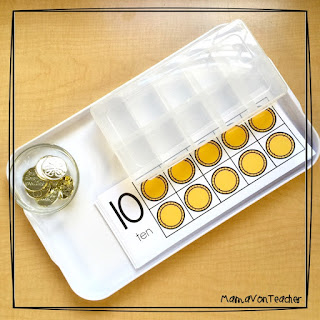Last year, on one of my frequent strolls through the craft store, I found this plain little plastic box in the beading aisle (I don't even bead, so I'm not sure why I was even in this aisle in the first place!).
 |
| Ten Frame Box |
I promptly bought one of these magnificent little boxes and tested it out in in my classroom. My students absolutely loved counting little objects into the box and it worked perfectly for my students who struggled with fine motor challenges - the items stay in their spaces baring completely knocking the entire box off of the table!
 |
| Ten Box Counting |
Initially, I kept the box in my circle time basket and had each of my preschoolers (this was a special education preschool classroom) choose a type of manipulative to count into the box to practice the number of the day. Each student took their turn while their peers practiced waiting, watching and listening to the students before him/her. The repetition and hands-on nature of this activity were perfect to reinforce counting, one-to-one correspondence, left-to-right object placement, order, organization, active looking and listening and more!
A colleague observed the little box in action and asked to borrow it to see if her students responded as well as mine had. I dutifully lent it to her, and never saw it again! Her students loved it just as much (maybe even more) than mine did. I bought another box and it too disappeared after lending it to another teacher in my building. I'm now on to my third or fourth box...
Recently, in my new classroom, I got brought the box out again and made some ten frame cards that fit almost perfectly under the box. The cards show the numeral and number word on the left and indicate which boxes should be filled to create the proper quantity.
I set it up as one of our Math works for March... I'll be changing out the manipulatives for Easter next week!
 |
| March Math Work |
You can get a FREE set of ten frame cards HERE if you'd like to try them out in your classroom.
The actual box that I used can be found at Michaels Stores or online HERE
Amazon has similar pack of three Bead Boxes
 |
| Ten Frame Math Center |





































